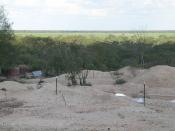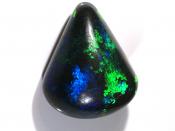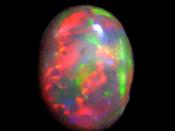Opal is the modern October birthstone and the accepted gem for the 13th wedding anniversary. Most opals are between 50-65 million years old, dating back to the Cretaceous period when dinosaurs roamed the earth. Opal formed as silica from decomposing rocks mixed with ground water which formed a silica gel that collected and hardened in underground cavities and fissures.
There are two distinct types of opal, common and precious. The way the silica particles form determines which type. In precious opal, silica particles are packed in regular rows and layers. Moving the stone causes light to diffract, or split, as it grazes the opal surface. This light diffusion shows iridescent flashes of green, blue, aqua and sometimes yellowish or red colors which are referred to as fire.
Black Opal comes from the Lightning Ridge region of Northern New South Wales. It is the most rare and most valuable opal. Fine quality black opals often cost more per carat than diamonds.
The term black opal is misleading because the opal is not actually black, but instead has a very dark base. This dark base enhances the brilliant colors know as fire.
Light opal is the most common type of opal found and refers to both the crystal type opal (translucent) and the milky opal (opaque). It is the most common variety and is generally less valuable than gem quality light opal. Brilliantly colored light opals may be quite expensive with a value exceeding some Black and Boulder Opals.
Brilliance or luster is one of the primary factors that determines an opal's value. An opal with strong intensity and color adds more value.
The hardness af an opal is between 5.5 and 6.5 on Moh's scale.
Most opals are found where geothermal hot springs dried up during seasonal periods of rainfall...


